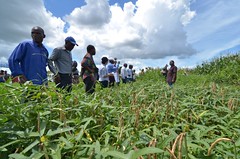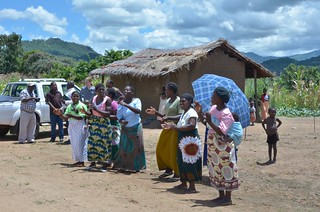Africa RISING researchers in learning visit to Malawi
A multidisciplinary team of researchers from Africa RISING recently visited Malawi as part of a learning exchange visit of project sites and trials. Members of the team came from Kenya, Tanzania, Zambia, and Ethiopia representing the various CGIAR Centres implementing the project such as the International Institute for Tropical Agriculture (IITA), the International Food Policy Research Institute (IFPRI), the International Wheat and Maize Improvement Center (CIMMYT), the International Livestock Research Institute (ILRI), and the International Crops Research Institute for Semi-Arid Tropics (ICRISAT). They also represented partner organizations AVRDC (the World Vegetable Center), the Zambia Agricultural Research Institute (ZARI), Total Land Care (TLC), the Zambia Ministry of Agriculture and Livestock (MAL), and the Morogoro-based Sokoine University of Agriculture (SUA).
They visited Africa RISING trial sites in Dedza and Ntcheu districts in Malawi representing the three agroecological zones that the project is working in: the dry and hot lowlands, the moderate temperature mid-altitude zone, and the comparatively cooler high-altitude zone. The researchers visited some of the “Mother-Baby” trials that the project is conducting in these two districts.

The visit was coordinated by Regis Chikowo, Senior Research Associate with Michigan State University and IITA/Africa-RISING’s focal point person in Malawi. Dr Chikowo also served as the technical resource person during the field visit.
At the sites, the team saw the many agricultural technologies that Africa RISING is introducing, particularly those that promote sustainable intensification and soil nutrient optimization. The researchers also had the opportunity to interact with the farmers running the mother-baby trials.
“These trials are a blend of researcher-farmer designed and co-management,” said Dr Chikowo. “What we want our farmer-partners to achieve is experiential learning so that they may be able to decide by themselves which among these technologies are best suited to their conditions, so there is better targeting of technologies and increased system efficiency” he added.
Explaining a bit about the history of the mother-baby trial concept, Dr Chikowo said, “the term ‘mother-baby’ was actually coined by Malawian farmers some years ago. At that time, Professor Snapp, a researcher – like us – came to Malawi to introduce the concept but did not have a simple non-technical name for it that could be easily understood by farmers. So a farmer came up and said, “This is a ‘mother’ trial because it gives birth to other ‘baby’ trials”. Since then, the concept has been known as such.”
At the Golomoti Extension Planning Area (EPA)– a lowland site in the lakeshore zone within Dedza district, at about 500 m above sea level and characterized by alluvial soils – the farmer group managing one of the the mother trials explained to the visiting scientists about the technologies that they have there, particularly maize-legume rotation, the ‘doubled-up’ legume cropping system, residue integration in soils for nutrient augmentation, soybean inoculation, maize comparison (with and without fertilizer), and cowpea variety selection trials.
“In Golomoti, we have four mother trials,” the farmer group leader said, “and each mother has given birth to 60 babies, so we have 244 trials running simultaneously in this EPA– all of them managed by farmers and farmer-groups. We assemble at the mother trials as the main learning points but babies are important too” he added.

The team visited one of the baby trials in the area being managed by Mrs Agnes Stephen Phiri. Asked by one of the researchers why she has adopted some of the Africa RISING-introduced technologies, she simply replied, “I want to achieve the same production improvements that our group has achieved in the mother trial. For example, last year I had groundnut planted here,” Mrs Phiri said while pointing to a plot where there is now maize planted. “I have noticed that my maize this year is performing far better than the maize I had before planting groundnut in the same area.”
At Kasese village, Kandeu EPA in Ntcheu District – a site in the mid-altitude zone located about 950m above sea level and characterized by moderate temperatures and mostly sandy soil – the group visited another mother trial being managed by a farmer group led by Mr Glyn Tchale.
“We are in our second year of cropping under the Africa RISING project,” Mr Tchale said.
“Among the more notable technologies that we have here, ratooning could serve as possible substitute for using seeds, as well as legume-maize rotation for soil nutrient augmentation, ‘double-up’ legume cropping, and targeting of crops suited to the unique conditions of each farmer’s field.”
“Apart from soil fertility, we are also trying to address issues of food security and nutrition, particularly the planting and processing of soybeans into various food products. We are also planning to hold this year farmer field days to show other farmers in the area and adjacent communities the benefits of the various Africa RISING technologies that we have in our trials,” Mr Tchale revealed.
In Linthipe EPA, Dedza District the team visited another mother trial representing the high-altitude agrocecological zone located about 1250 m above sea level. Here, the farmers managing the trials highlighted the planting of legumes for soil fertility enhancement as well as the use of pigeon pea for food and as well as for animal feed.
Asked whether they will still continue with planting some of the introduced crops even after Africa RISING exits, the farmers resoundingly said “Yes!” We’ll continue with these crops, especially pigeon peas, as long as we can protect them from goats that eat them,” the farmers said. Apparently, according to the farmers, goats consider pigeon peas a delicacy. “The goats really like them (pigeon peas), so a lot of our pigeon pea plants are damaged by them.”
The Linthipe farmers also said that they have been approached by farmers from other villages asking for information about the technologies in the trials as well as requesting for seeds of some of the crops planted there, especially cowpeas. “They also have come to ask if they can be part of the project because they are impressed by the performance of the crops. So we help them in terms of providing information about the technologies and, sometimes, giving them seeds of the cowpea varieties that we have,” the lead farmer said.
On the part of the researchers, all said that they were impressed by what they saw in the field. Dr NVPR Ganga Rao, an ICRISAT plant breeder based in Nairobi, said
“We learned a lot during the visit, and I am particularly impressed by the performance of the farmers in managing the trials. I can also see that they are very dedicated to the project.”
Prof Yasinta Muzanila, Director of the Solomon Mahlangu Campus of the Sokoine University of Agriculture in Morogoro, Tanzania, added that “the farmers have a clear understanding of the vision of Africa RISING with regards to improving their lives through farm intensification. I am glad that I am in this trip as I learned a lot from the farmers and how they do things here in Malawi. Some of the concepts and technologies that I learned could be applied by farmers in Tanzania. I am quite excited to share this experience with them.”

Mr Mathias Zulu of ZARI based in Chipata, Eastern Province of Zambia, reiterated the two earlier statements. “The practice of the farmers here in Malawi is very similar to what we have in the Eastern Province of Zambia. But I also picked up some things that could further improve the way farmers in Zambia grow their crops, particularly maize.” Mr Zulu particularly pointed out the practice of intercropping maize and climbing beans, with the maize stalks serving as support for the beans.
“This practice (of intercropping maize with climbing beans) could help farmers in Zambia not only maximize the use of their land but also augment their incomes, diets, and nutrition,” he added. “So we are not only improving their livelihoods but also their well-being,” Mr Zulu concluded.
More photos from the visit
Story by Jeffrey Oliver, International Institute for Tropical Agriculture




